Investigating the Reliability of Nonlinear Static Procedures for the Seismic Assessment of Existing Masonry Buildings
Abstract
:1. Introduction
2. Basics of Nonlinear Static Procedures Adopted in Standards
- The execution of an NLSA to obtain the pushover curve (representative of the original multi-degree-of-freedom—MDOF—system) aimed at describing the evolution of the structural response in a nonlinear range;
- The adoption of criteria to define the attainment of given limit states on the pushover curve;
- The conversion of the MDOF into an equivalent single-degree-of-freedom (SDOF) representation of the system;
- The adoption of a procedure to assess the displacement demand expected given a seismic input, which is expressed in NSPs in terms of response spectra.
| Reference | N2 Methods and CSM for d*max Calculation | Equation |
|---|---|---|
| N2, Fajfar et al. (2000) [33] | (4) | |
| N2, Guerrini et al. (2017) [57] | For Configuration C: For Configurations A and B: | (5) |
| N2, Marino et al. (2019) [32] | | (6) |
| CSM [34] | (7) |
- Structures with high dissipative capacity: k = 1;
- Structures with moderate dissipative capacity: k = 0.66;
- Structures with low dissipative capacity: k = 0.33.
3. Criteria Adopted to Assess the Reliability of the Examined Approaches
3.1. Assessment of the Reference/Target Fragility Curve by Nonlinear Dynamic Analyses
3.2. Assessment of Fragility Curves by Nonlinear Static Analyses
4. Masonry Building Prototype: Modeling and Preliminary Nonlinear Analyses
4.1. Description and Modeling
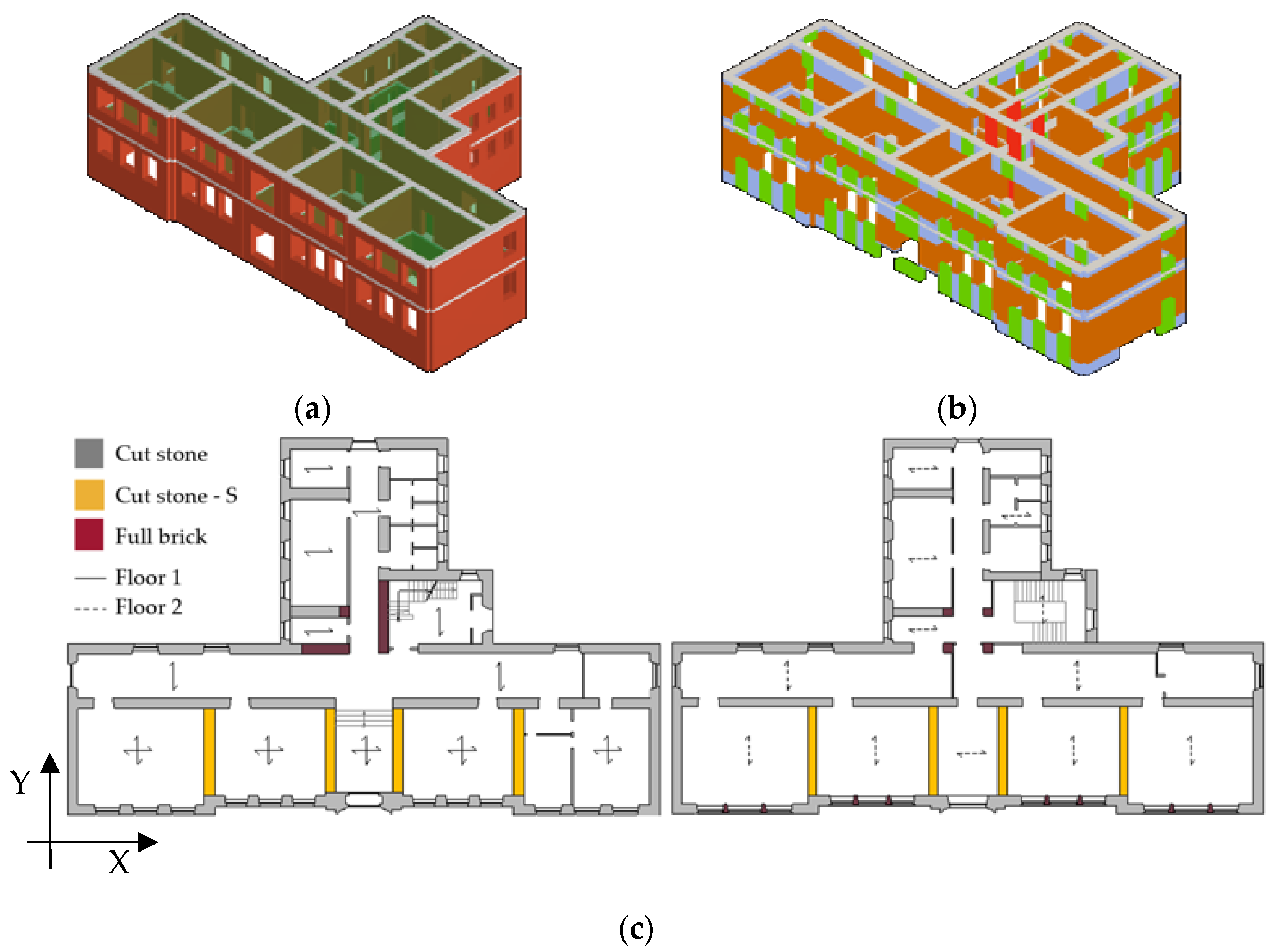

- Case A assumes the absence of reinforced concrete beams coupled to the spandrels and good interlocking between the external and internal walls;
- Case B assumes the absence of reinforced concrete beams coupled to the spandrels and poor interlocking between the external and internal walls;
- Case C assumes that RC ring beams are coupled to the spandrels and there is good interlocking between the external and internal walls.
- Unconsolidated cut stone masonry, which characterizes the majority of the wall panels;
- Consolidated (through injections) cut stone masonry, which involves some internal side panels oriented perpendicularly to the main façade;
- Full brick masonry with lime mortar, which some internal pillars and an internal wall are composed of.
| Mortar | Cross Connection | Injections | |||||||
|---|---|---|---|---|---|---|---|---|---|
| Cut stone increase | 1.3 | 1.3 | 1.5 | ||||||
| Full brick increase | 1.47 | 1.3 | - | ||||||
| [ | [ | E [ | |||||||
| min | median | max incremented | min | median | max incremented | min | median | max incremented | |
| Cut stone unconsolidated | 2.6 | 4.09 | 6.42 | 0.056 | 0.084 | 0.125 | 1500 | 1965 | 2574 |
| Cut stone consolidated | 3.9 | 7.51 | 14.45 | 0.084 | 0.154 | 0.281 | 2250 | 3610 | 5792 |
| Full brick | 2.6 | 4.62 | 8.21 | 0.050 | 0.111 | 0.248 | 1200 | 1781 | 2644 |
| Parameter | Median Value | β | |
|---|---|---|---|
| Cut stone unconsolidated | 1965 | 0.27 | |
| 4.09 | 0.45 | ||
| 0.084 | 0.40 | ||
| 0.005 | 0.57 | ||
| 0.010 | 0.51 | ||
| Cut stone consolidated | 3610 | 0.47 | |
| 7.51 | 0.65 | ||
| 0.154 | 0.60 | ||
| 0.007 | 0.57 | ||
| 0.012 | 0.51 | ||
| Full brick | 1781 | 0.40 | |
| 4.62 | 0.58 | ||
| 0.111 | 0.80 | ||
| 0.005 | 0.40 | ||
| 0.010 | 0.40 |

4.2. Seismic Response of Set Configurations Simulated by Nonlinear Static Analyses
| Wall no.9 (X Dir.) | Wall no.12 (Y Dir.) | |
| Configuration C | 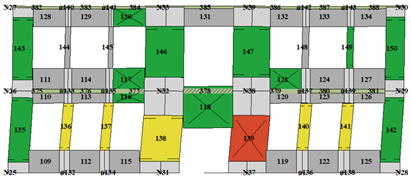 | 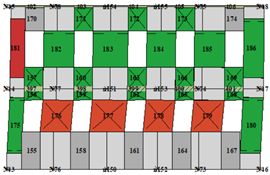 |
| Configuration A | 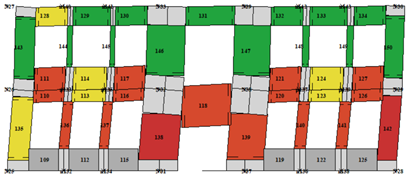 | 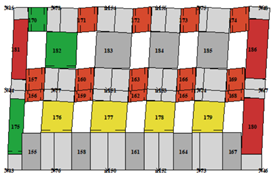 |
| Configuration B | 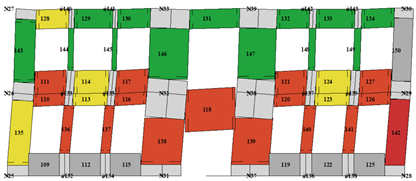 | 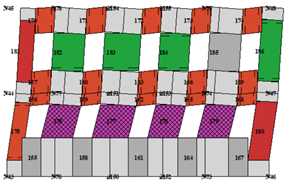 |
| (a) | (b) | |
 | (c) |

5. Results
5.1. Influence of the Approach Adopted to Compute the Displacement Demand in N2-Based and CSM-Based Methods
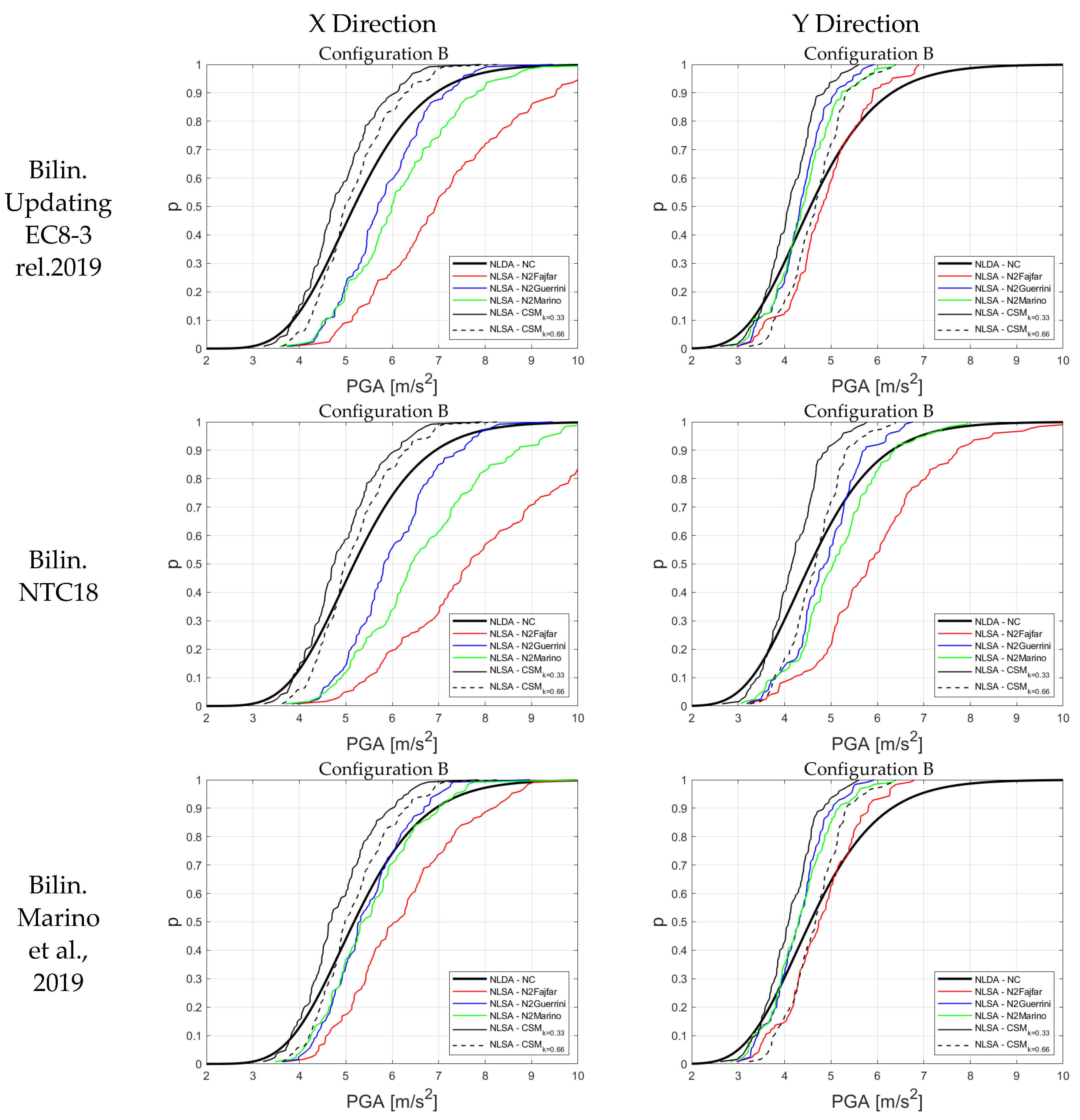
5.2. Influence of the Criteria Adopted for the Bilinear Idealization of the Pushover Curve
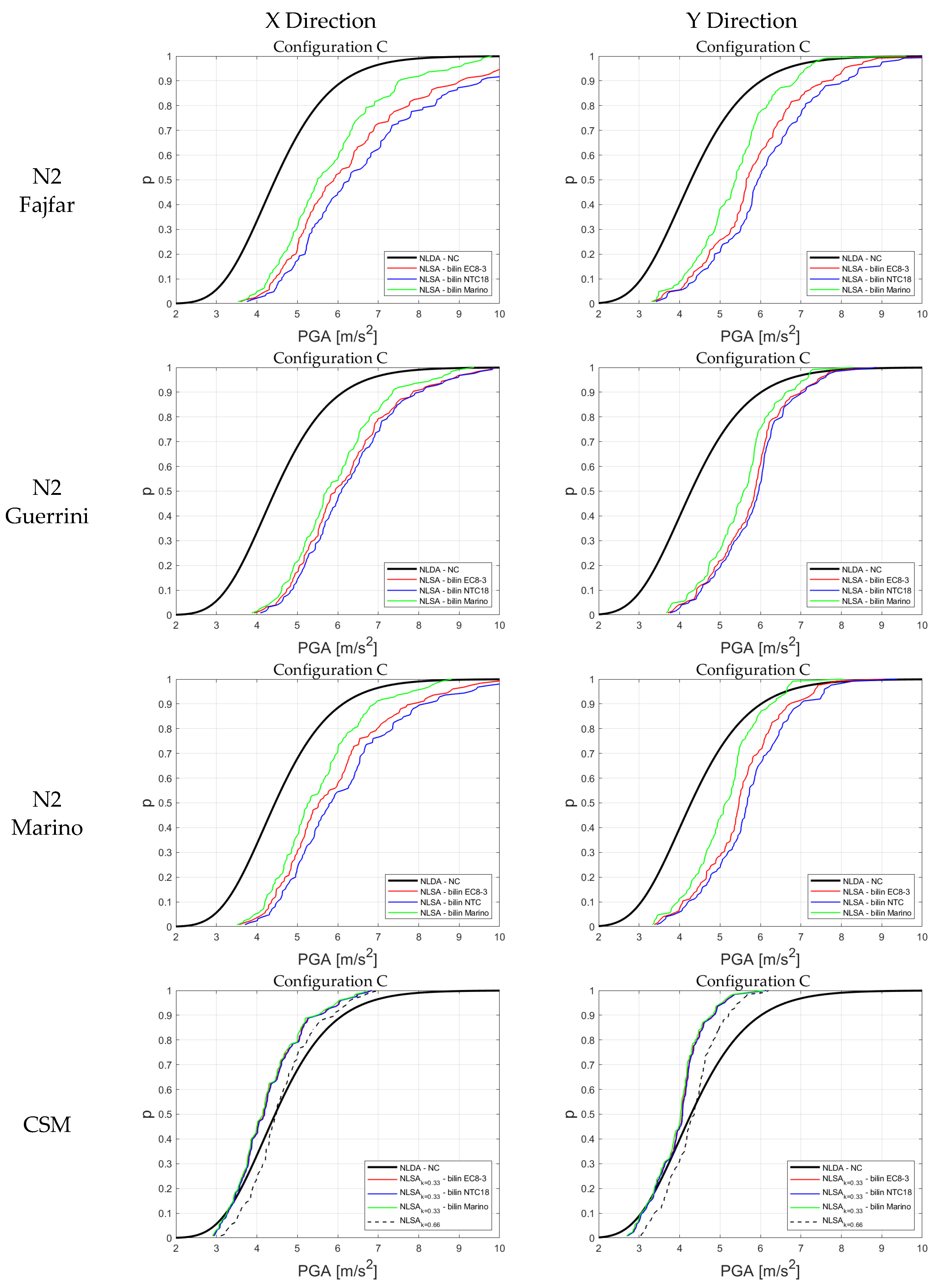
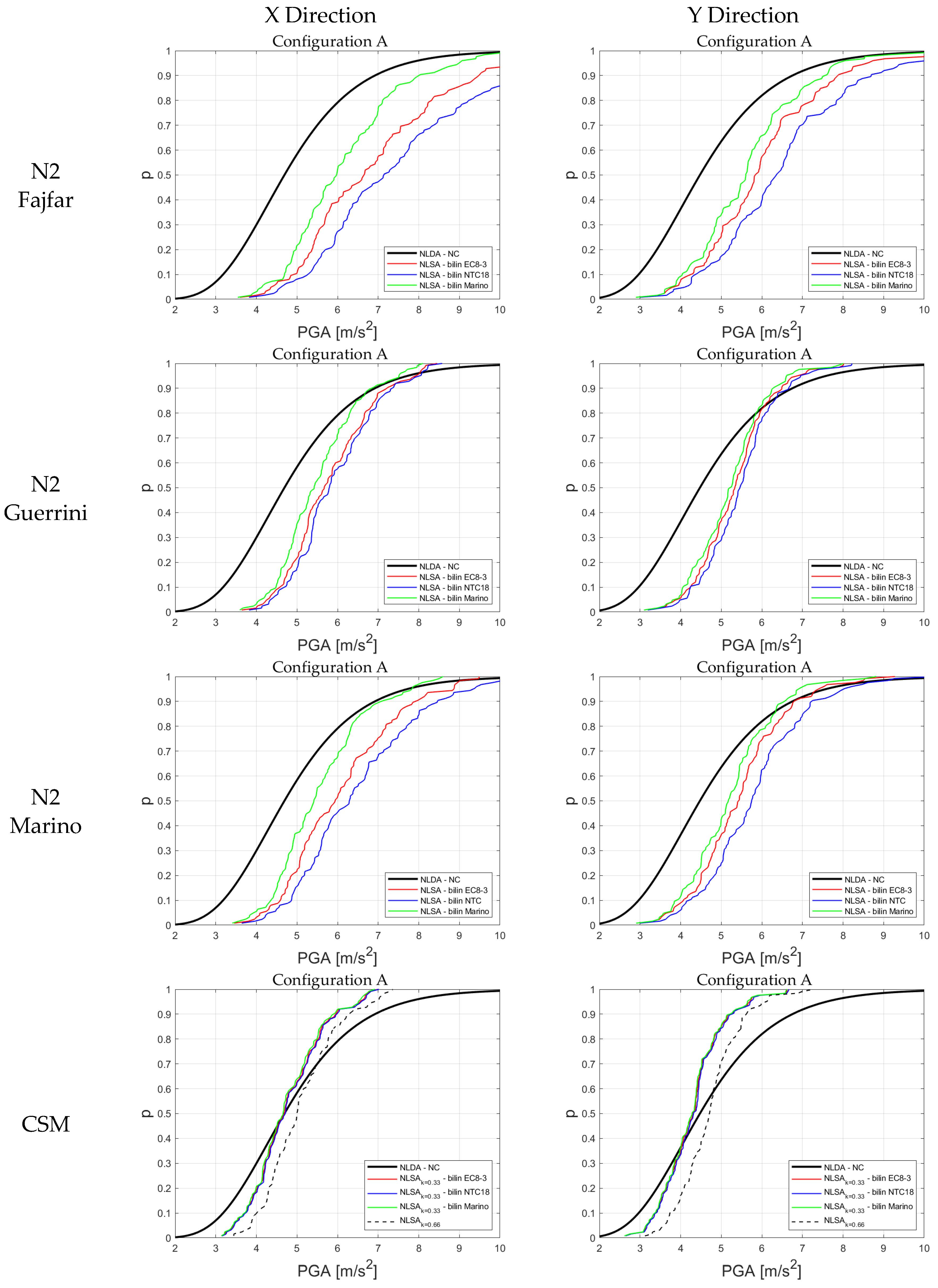

6. Conclusions
Author Contributions
Funding
Institutional Review Board Statement
Informed Consent Statement
Data Availability Statement
Acknowledgments
Conflicts of Interest
References
- D’Ayala, D.F.; Paganoni, S. Assessment and analysis of damage in L’Aquila historic city centre after 6th April 2009. Bull. Earthq. Eng. 2011, 9, 81–104. [Google Scholar] [CrossRef]
- Sorrentino, L.; Cattari, S.; da Porto, F.; Magenes, G.; Penna, A. Seismic behaviour of ordinary masonry buildings during the 2016 central Italy earthquakes. Bull. Earthq. Eng. 2019, 17, 5583–5607. [Google Scholar] [CrossRef]
- Penna, A.; Morandi, P.; Rota, M.; Manzini, C.F.; da Porto, F.; Magenes, G. Performance of masonry buildings during the Emilia 2012 earthquake. Bull. Earthq. Eng. 2013, 12, 2255–2273. [Google Scholar] [CrossRef]
- Albanesi, T.; Nuti, C.; Vanzi, I. State of the art of non linear static methods. In Proceedings of the 12th European Conference on Earthquake Engineering, London, UK, 9–13 September 2002; Available online: https://api.semanticscholar.org/CorpusID:117719266 (accessed on 24 September 2015).
- Aşıkoğlu, A.; Vasconcelos, G.; Lourenço, P.B. Overview on the Nonlinear Static Procedures and Performance-Based Approach on Modern Unreinforced Masonry Buildings with Structural Irregularity. Buildings 2021, 11, 147. [Google Scholar] [CrossRef]
- Fajfar, P. Analysis in seismic provisions for buildings: Past, present and future. Bull. Earthq. Eng. 2018, 16, 2567–2608. [Google Scholar] [CrossRef]
- EN 1998-3:2005; Eurocode 8: Design of Structures for Earthquake Resistance—Part 3: Assessment and Retrofitting of Buildings and Bridges. European Committee for Standardization: Brussels, Belgium, 2005.
- NTC. Decreto Ministeriale 17/1/2018. Norme Tecniche per le Costruzioni; Ministry of Infrastructures and Transportations: Rome, Italy, 2018.
- FEMA 440. Improvement of Nonlinear Static Seismic Analysis Procedures; Federal Emergency Management Agency: Washington, DC, USA, 2005.
- ASCE/SEI 41-13; Seismic Evaluation and Retrofit of Existing Buildings. American Society of Civil Engineers: Reston, VA, USA, 2014.
- NZSEE. The Seismic Assessment of Existing Buildings (the Guidelines). 2017. Available online: http://www.eq-assess.org.nz (accessed on 26 January 2024).
- Tomazevic, M.; Bosiljkov, V.; Weiss, P. Structural behavior factor for masonry structures. In Proceedings of the 13th World Conference on Earthquake Engineering, Vancouver, BC, Canada, 1–6 August 2004; Available online: https://www.iitk.ac.in/nicee/wcee/article/13_2642.pdf (accessed on 1 January 2021).
- Chourasia, A.; Singhal, S.; Bhargava, P. Damage limitation and structural behaviour factor for masonry structures. Aust. J. Struct. Eng. 2021, 22, 19–28. [Google Scholar] [CrossRef]
- Morandi, P.; Butenweg, C.; Breis, K.; Beyer, K.; Magenes, G. Latest findings on the behaviour factor q for the seismic design of URM buildings. Bull. Earthq. Eng. 2022, 20, 5797–5848. [Google Scholar] [CrossRef]
- Morandi, P.; Manzini, C.F.; Magenes, G. Application of seismic design procedures on three modern URM buildings struck by the 2012 Emilia earthquakes: Inconsistencies and improvement proposals in the European codes. Bull. Earthq. Eng. 2020, 18, 547–580. [Google Scholar] [CrossRef]
- Manzini, C.F.; Magenes, G.; Penna, A.; da Porto, F.; Camilletti, D.; Cattari, S.; Lagomarsino, S. Masonry Italian Code-Conforming Buildings. Part 1: Case Studies and Design Methods. J. Earthq. Eng. 2018, 22, 54–73. [Google Scholar] [CrossRef]
- Lagomarsino, S.; Marino, S.; Cattari, S. Linear static procedures for the seismic assessment of masonry buildings: Open issues in the new generation of European codes. Structures 2020, 26, 427–440. [Google Scholar] [CrossRef]
- Cattari, S.; Calderoni, B.; Caliò, I.; Camata, G.; de Miranda, S.; Magenes, G.; Milani, G.; Saetta, A. Nonlinear modeling of the seismic response of masonry structures: Critical review and open issues towards engineering practice. Bull. Earthq. Eng. 2022, 20, 1939–1997. [Google Scholar] [CrossRef]
- Lagomarsino, S.; Cattari, S. Seismic Performance of Historical Masonry Structures Through Pushover and Nonlinear Dynamic Analyses. Geotech. Geol. Earthq. Eng. 2015, 39, 265–292. [Google Scholar] [CrossRef]
- Palanci, M.; Demir, A.; Kayhan, A.H. Quantifying the effect of amplitude scaling of real ground motions based on structural responses of vertically irregular and regular RC frames. Structures 2023, 51, 105–123. [Google Scholar] [CrossRef]
- Dávalos, H.; Miranda, E. Evaluation of bias on the probability of collapse from amplitude scaling using spectral-shape-matched records. Earthq. Eng. Struct. Dyn. 2019, 48, 970–986. [Google Scholar] [CrossRef]
- Demir, A.; Kayhan, A.H.; Palanci, M. Response- and probability-based evaluation of spectrally matched ground motion selection strategies for bi-directional dynamic analysis of low- to mid-rise RC buildings. Structures 2023, 58, 105533. [Google Scholar] [CrossRef]
- Iervolino, I.; Galasso, C.; Cosenza, E. REXEL: Computer aided record selection for code-based seismic structural analysis. Bull. Earthq. Eng. 2009, 8, 339–362. [Google Scholar] [CrossRef]
- Iervolino, I.; Galasso, C.; Paolucci, R.; Pacor, F. Engineering ground motion record selection in the ITalian ACcelerometric Archive. Bull. Earthq. Eng. 2011, 9, 1761–1778. [Google Scholar] [CrossRef]
- Sgobba, S.; Puglia, R.; Pacor, F.; Luzi, L.; Russo, E.; Felicetta, C.; Lanzano, G.; D’Amico, M.; Baraschino, R.; Baltzopoulos, G.; et al. REXELweb: A Tool for Selection of Ground-Motion Records from the Engineering Strong Motion Database (ESM). In Proceedings of the 7th International Conference on Earthquake Geotechnical Engineering, Rome, Italy, 17–20 June 2019; Available online: https://www.researchgate.net/publication/333895014_REXELweb_A_tool_for_selection_of_ground-motion_records_from_the_Engineering_Strong_Motion_database_ESM (accessed on 26 January 2024).
- Manfredi, V.; Masi, A.; Özcebe, A.G.; Paolucci, R.; Smerzini, C. Selection and spectral matching of recorded ground motions for seismic fragility analyses. Bull. Earthq. Eng. 2022, 20, 4961–4987. [Google Scholar] [CrossRef]
- Smerzini, C.; Amendola, C.; Paolucci, R.; Bazrafshan, A. Engineering validation of BB-SPEEDset, a data set of near-source physics-based simulated accelerograms. Earthq Spectra. 2023. [Google Scholar] [CrossRef]
- Brunelli, A.; de Silva, F.; Piro, A.; Parisi, F.; Sica, S.; Silvestri, F.; Cattari, S. Numerical simulation of the seismic response and soil–structure interaction for a monitored masonry school building damaged by the 2016 Central Italy earthquake. Bull. Earthq. Eng. 2021, 19, 1181–1211. [Google Scholar] [CrossRef]
- Parisse, F.; Marques, R.; Cattari, S.; Lourenco, P. Implications of Modelling Assumptions on the Seismic Assessment of URM Structures through FE and SE-Based Approaches. In Proceedings of the 3rd European Conference on Earthquake Engineering and Seismology, Bucharest, Romania, 4–9 September 2022; Available online: https://www.researchgate.net/publication/363738779_Implications_of_modelling_assumptions_on_the_seismic_assessment_of_URM_structures_through_FE_and_SE-based_approaches (accessed on 26 January 2024).
- Astroza, R.; Alessandri, A. Effects of model uncertainty in nonlinear structural finite element model updating by numerical simulation of building structures. Struct. Control Health Monit. 2019, 26, e2297. [Google Scholar] [CrossRef]
- Lagomarsino, S.; Cattari, S. PERPETUATE guidelines for seismic performance-based assessment of cultural heritage masonry structures. Bull. Earthq. Eng. 2015, 13, 13–47. [Google Scholar] [CrossRef]
- Marino, S.; Cattari, S.; Lagomarsino, S. Are the nonlinear static procedures feasible for the seismic assessment of irregular existing masonry buildings? Eng. Struct. 2019, 200, 109700. [Google Scholar] [CrossRef]
- Fajfar, P.; Fischinger, M. N2-A Method for Nonlinear Seismic Analysis of Regular Buildings. In Proceedings of the 9th World Conference on Earthquake Engineering, Tokyo, Japan, 2–6 August 1988; Volume 5, pp. 111–116. [Google Scholar]
- Freeman, S. Review of the development of the capacity spectrum method. ISET J. Earthq. Technol. 2004, 41, 1–13. [Google Scholar]
- Fajfar, P.; Marusic, D.; Perus, I. Torsional effects in the pushover-based seismic analysis of buildings. J. Earthq. Eng. 2005, 9, 831–854. [Google Scholar] [CrossRef]
- Bento, R.; Bhatt, C.; Pinho, R. Using nonlinear static procedures for seismic assessment of the 3D irregular SPEAR building. Earthq. Struct. 2010, 1, 177–195. [Google Scholar] [CrossRef]
- Stefano, M.; Mariani, V. Pushover Analysis for Plan Irregular Building Structures. In Geotechnical, Geological and Earthquake Engineering; Springer: Cham, Switzerland, 2014; Volume 34, pp. 429–448. [Google Scholar] [CrossRef]
- Adhikari, R.; D’Ayala, D. Applied Element Modelling and Pushover Analysis of Unreinforced Masonry Buildings with Flexible Roof Diaphragm; European Community on Computational Methods in Applied Sciences: Barcelona, Spain, 2019. [Google Scholar] [CrossRef]
- Nakamura, Y.; Derakhshan, H.; Griffith, M.; Magenes, G.; Sheikh, A. Applicability of nonlinear static procedures for low-rise unreinforced masonry buildings with flexible diaphragms. Eng. Struct. 2017, 137, 1–18. [Google Scholar] [CrossRef]
- Lagomarsino, S.; Camilletti, D.; Cattari, S.; Marino, S. Seismic Assessment of Existing Irregular Masonry Buildings by Nonlinear Static and Dynamic Analyses. In Geotechnical, Geological and Earthquake Engineering; Springer: Cham, Switzerland, 2018; pp. 123–151. [Google Scholar] [CrossRef]
- Rossetto, T.; D’Ayala, D.; Ioannou, I.; Meslem, A. Evaluation of Existing Fragility Curves. In SYNER-G: Typology Definition and Fragility Functions for Physical Elements at Seismic Risk; Springer: Dordrecht, The Netherlands, 2014; pp. 47–93. [Google Scholar] [CrossRef]
- Baraschino, R.; Baltzopoulos, G.; Iervolino, I. R2R-EU: Software for fragility fitting and evaluation of estimation uncertainty in seismic risk analysis. Soil Dyn. Earthq. Eng. 2020, 132, 106093. [Google Scholar] [CrossRef]
- Lagomarsino, S.; Cattari, S. Fragility Functions of Masonry Buildings; Springer: Dordrecht, The Netherlands, 2014; Volume 27, pp. 111–156. [Google Scholar] [CrossRef]
- Urlainis, A.; Shohet, I.M. Seismic Risk Mitigation and Management for Critical Infrastructures Using an RMIR Indicator. Buildings 2022, 12, 1748. [Google Scholar] [CrossRef]
- Follador, V.; Carpanese, P.; Donà, M.; Alfano, S.; Cattari, S.; Lagomarsino, S.; da Porto, F. Comparison of Fragility Sets to Assess the Effectiveness of Retrofit Interventions on Masonry Buildings in Italy. Buildings 2023, 13, 2937. [Google Scholar] [CrossRef]
- Rosti, A.; Rota, M.; Penna, A. Empirical fragility curves for Italian URM buildings. Bull. Earthq. Eng. 2021, 19, 3057–3076. [Google Scholar] [CrossRef]
- Donà, M.; Carpanese, P.; Follador, V.; Sbrogiò, L.; da Porto, F. Mechanics-based fragility curves for Italian residential URM buildings. Bull. Earthq. Eng. 2021, 19, 3099–3127. [Google Scholar] [CrossRef]
- Cirak Karakas, C.; Palanci, M.; Senel, S.M. Fragility based evaluation of different code based assessment approaches for the performance estimation of existing buildings. Bull. Earthq. Eng. 2022, 20, 1685–1716. [Google Scholar] [CrossRef]
- EN 1998-1:2004; Eurocode 8: Design of Structures for Earthquake Resistance—Part 1: General Rules, Seismic Actions and Rules for Buildings. European Committee for Standardization: Brussels, Belgium, 2004.
- Antoniou, S.; Pinho, R. Advantage and limitations of adaptive and non-adaptive force-based pushover procedures. J. Earthq. Eng. 2004, 8, 497–522. [Google Scholar] [CrossRef]
- Antoniou, S.; Pinho, R. Development and verification of a displacement-based adaptive pushover procedure. J. Earthq. Eng. 2004, 8, 643–661. [Google Scholar] [CrossRef]
- Cattari, S.; Camilletti, D.; Lagomarsino, S.; Bracchi, S.; Rota, M.; Penna, A. Masonry Italian Code-Conforming Buildings. Part 2: Nonlinear Modelling and Time-History Analysis. J. Earthq. Eng. 2018, 22 (Suppl. S2), 2010–2040. [Google Scholar] [CrossRef]
- Iervolino, I.; Spillatura, A.; Bazzurro, P. Seismic Reliability of Code-Conforming Italian Buildings. J. Earthq. Eng. 2018, 22, 5–27. [Google Scholar] [CrossRef]
- De Risi, M.T.; Di Domenico, M.; Manfredi, V.; Terrenzi, M.; Camata, G.; Mollaioli, F.; Noto, F.; Ricci, P.; Franchin, P.; Masi, A.; et al. Modelling and Seismic Response Analysis of Italian Pre-Code and Low-Code Reinforced Concrete Buildings. Part I: Bare Frames. J. Earthq. Eng. 2022, 27, 1482–1513. [Google Scholar] [CrossRef]
- Fajfar, P. A Nonlinear Analysis Method for Performance-Based Seismic Design. Earthq. Spectra 2000, 16, 573–592. [Google Scholar] [CrossRef]
- prEN 1998-3:2019; Eurocode 8: Design of Structures for Earthquake Resistance—Part 3: Assessment and Retrofitting of Buildings and Bridges. The European Union: Brussels, Belgium; Luxembourg, 2019; updating September 2019.
- Guerrini, G.; Graziotti, F.; Penna, A.; Magenes, G. Improved evaluation of inelastic displacement demands for short-period masonry structures. Earthq. Eng. Struct. Dyn. 2017, 46, 1411–1430. [Google Scholar] [CrossRef]
- Vamvatsikos, D.; Cornell, C. Incremental Dynamic Analysis. Earthq. Eng. Struct. Dyn. 2002, 31, 491–514. [Google Scholar] [CrossRef]
- Phadnis, P.; Desai, R.; Tande, S.; Dhumal, P. Fragility analysis of masonry infill R.C. frame using incremental dynamic approach. Asian J. Civ. Eng. 2023, 24, 3375–3386. [Google Scholar] [CrossRef]
- Jalayer, F.; Cornell, C. Alternative non-linear demand estimation methods for probability-based seismic assessments. Earthq. Eng. Struct. Dyn. 2009, 38, 951–972. [Google Scholar] [CrossRef]
- Bazzurro, P.; Cornell, C.; Shome, N.; Carballo, J. Three Proposals for Characterizing MDOF Nonlinear Seismic Response. J. Struct. Eng-Asce 1998, 124, 1281–1289. [Google Scholar] [CrossRef]
- Jalayer, F.; Risi, R.; Manfredi, G. Bayesian Cloud Analysis: Efficient structural fragility assessment using linear regression. Bull. Earthq. Eng. 2014, 13, 1183–1203. [Google Scholar] [CrossRef]
- Shome, N. Probabilistic Seismic Demand Analysis of Nonlinear Structures. Ph.D. Thesis, Stanford University, Stanford, CA, USA, 1999. [Google Scholar]
- Elenas, A.; Meskouris, K. Correlation study between seismic acceleration parameters and damage indices of structures. Eng. Struct. 2001, 23, 698–704. [Google Scholar] [CrossRef]
- Luco, N.; Cornell, C.A. Structure-Specific Scalar Intensity Measures for Near-Source and Ordinary Earthquake Ground Motions. Earthq. Spectra 2007, 23, 357–392. [Google Scholar] [CrossRef]
- Mollaioli, F.; Lucchini, A.; Cheng, Y.; Monti, G. Intensity measures for the seismic response prediction of base-isolated buildings. Bull. Earthq. Eng. 2013, 11, 1841–1866. [Google Scholar] [CrossRef]
- Minas, S.; Galasso, C. Accounting for spectral shape in simplified fragility analysis of case-study reinforced concrete frames. Soil Dyn. Earthq. Eng. 2019, 119, 91–103. [Google Scholar] [CrossRef]
- Iervolino, I.; Maddaloni, G.; Cosenza, E. Eurocode 8 Compliant Real Record Sets for Seismic Analysis of Structures. J. Earthq. Eng. 2008, 12, 54–90. [Google Scholar] [CrossRef]
- Masi, A.; Lagomarsino, S.; Dolce, M.; Manfredi, V.; Ottonelli, D. Towards the updated Italian seismic risk assessment: Exposure and vulnerability modelling. Bull. Earthq. Eng. 2021, 19, 3253–3286. [Google Scholar] [CrossRef]
- Iervolino, I.; Chioccarelli, E.; Convertito, V. Engineering design earthquakes from multimodal hazard disaggregation. Soil Dyn. Earthq. Eng. 2011, 31, 1212–1231. [Google Scholar] [CrossRef]
- Cipriano, A. Impact of Italian Ground Motion Models in Seismic Hazard Assessment: Case Studies in Near-Source Region and Volcanic Context. ING I—Scuola di Ingegneria Civile, Ambientale e Territoriale. Politecnico di Milano. 2022. Available online: https://hdl.handle.net/10589/197115 (accessed on 1 December 2022).
- Rebez, A.; Peruzza, L.; Slejko, D. Probabilistic spectral seismic hazard assessment for Italy. Boll. Geofis. Teor. Appl. 1999, 40, 31–51. [Google Scholar]
- Kita, A.; Cavalagli, N.; Masciotta, M.; Lourenco, P.; Ubertini, F. Rapid post-earthquake damage localization and quantification in masonry structures through multidimensional non-linear seismic IDA. Eng. Struct. 2020, 219, 110841. [Google Scholar] [CrossRef]
- Ghosh, A.K.; Kushwaha, H.S. Sensitivity of Seismic Hazard to Various Parameters and Correlations for Peak Ground Acceleration. 1998; pp. 1–25. Available online: http://inis.iaea.org/search/search.aspx?orig_q=RN:30017533 (accessed on 1 January 2022).
- Whitlock, P.A.; Kalos, M. Monte Carlo Methods; Wiley: Hoboken, NJ, USA, 1986. [Google Scholar]
- Vargas, Y.F.; Pujades, L.G.; Barbat, A.H.; Hurtado, J.E. Capacity, fragility and damage in reinforced concrete buildings: A probabilistic approach. Bull. Earthq. Eng. 2013, 11, 2007–2032. [Google Scholar] [CrossRef]
- Cattari, S.; Degli Abbati, S.; Ottonelli, D.; Marano, C.; Camata, G.; Spacone, E.; Da Porto, F.; Modena, C.; Lorenzoni, F.; Magenes, G.; et al. Discussion on data recorded by the Italian structural seismic monitoring network on three masonry structures hit by the 2016–2017 Central Italy earthquake. In Proceedings of the 7th International Conference on Computational Methods in Structural Dynamics and Earthquake Engineering Methods in Structural Dynamics and Earthquake Engineering, Crete, Greece, 24–26 June 2019; pp. 1889–1906. [Google Scholar] [CrossRef]
- Ferrero, C.; Lourenco, P.; Calderini, C. Nonlinear modeling of unreinforced masonry structures under seismic actions: Validation using a building hit by the 2016 Central Italy earthquake. Frat. Integrità Strutt. 2020, XIV, 92–114. [Google Scholar] [CrossRef]
- Lagomarsino, S.; Penna, A.; Galasco, A.; Cattari, S. TREMURI program: An equivalent frame model for the nonlinear seismic analysis of masonry buildings. Eng. Struct. 2013, 56, 1787–1799. [Google Scholar] [CrossRef]
- Cattari, S.; Lagomarsino, S. Masonry Structures. In Developments in the Field of Displacement Based Seismic Assessment; IUSS Press and EU CENTRE: Pavia, Italy, 2013; p. 524. ISBN 978-88-6198-090-7. [Google Scholar]
- Cattari, S.; Alfano, S.; Lagomarsino, S. A Practice-Oriented Proposal to Consider the Flange Effect in Equivalent Frame Modeling of Masonry Buildings. Buildings 2023, 13, 462. [Google Scholar] [CrossRef]
- Circolare. Istruzioni per L’applicazione dell’«Aggiornamento delle “Norme Tecniche per le Costruzioni”» di cui al Decreto Ministeriale 17 Gennaio 2018. G.U.S.O. n. 29 of 27/7/2018, No. 42, 21 gennaio 2019. Available online: https://www.lavoripubblici.it/normativa/20190121/Circolare-Ministero-delle-infrastrutture-e-dei-trasporti-21-gennaio-2019-n-7-18430.html (accessed on 26 January 2024).
- Franchin, P.; Ragni, L.; Rota, M.; Zona, A. Modelling Uncertainties of Italian Code-Conforming Structures for the Purpose of Seismic Response Analysis. J. Earthq. Eng. 2018, 22 (Suppl. S2), 1964–1989. [Google Scholar] [CrossRef]

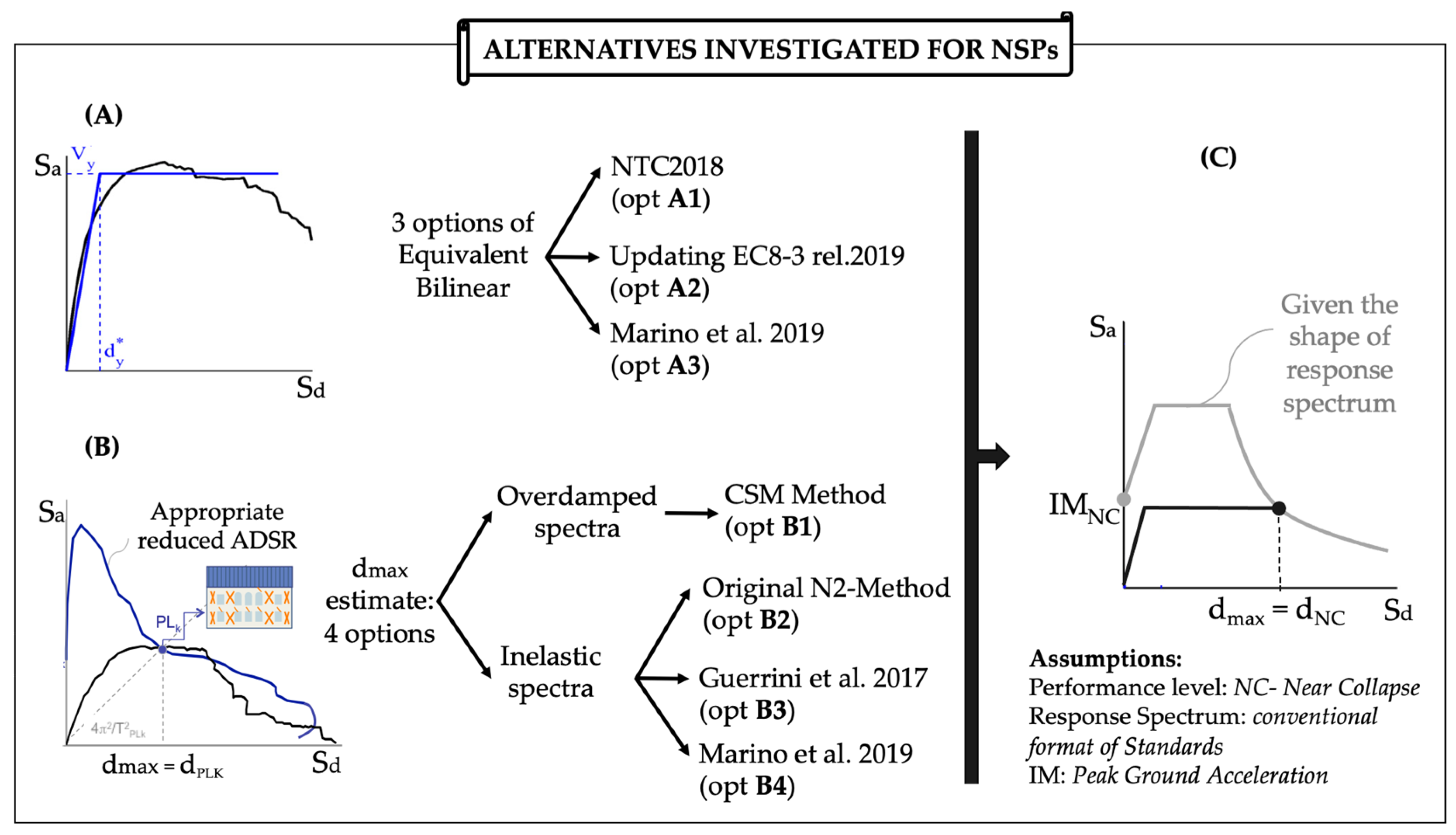


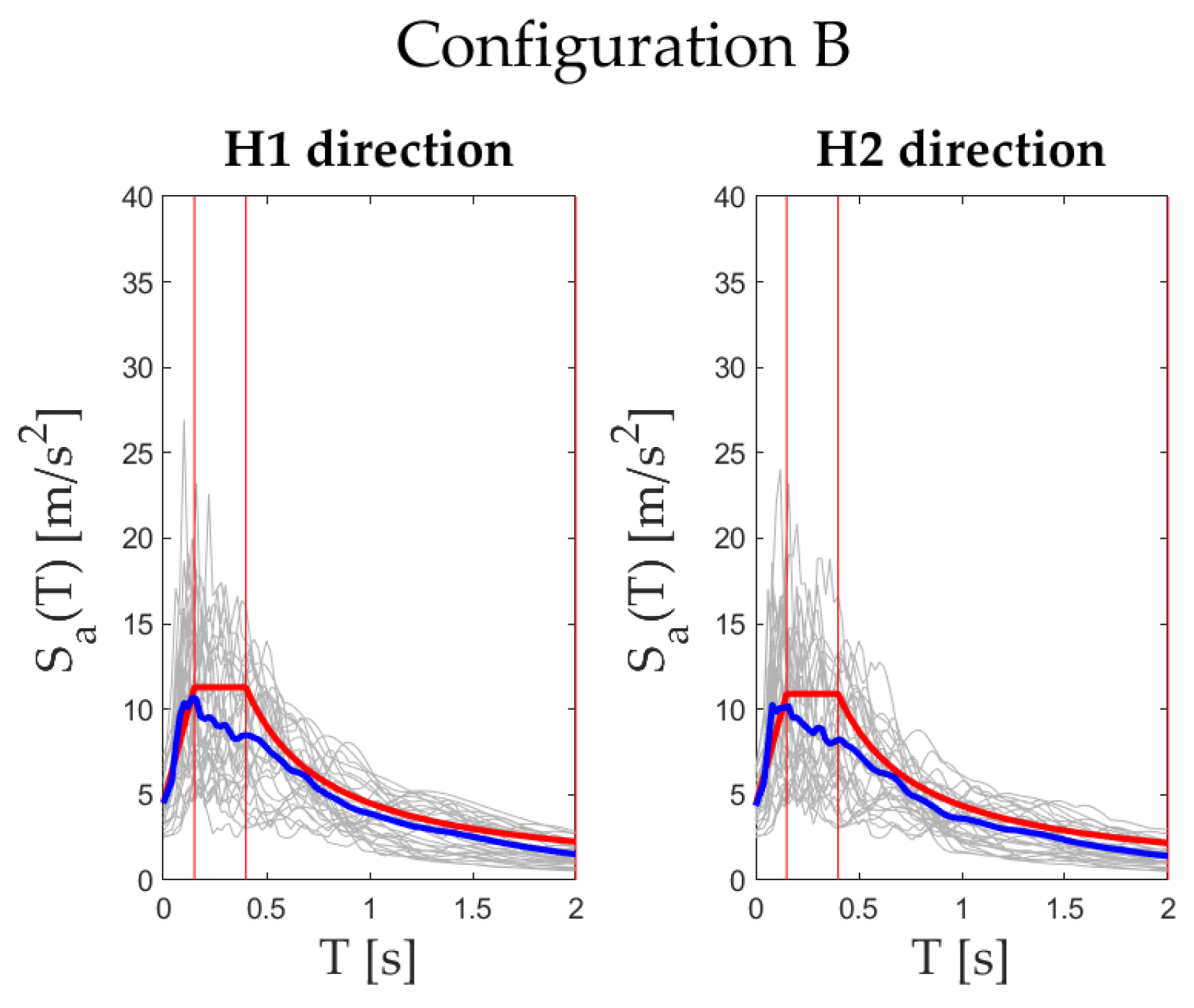
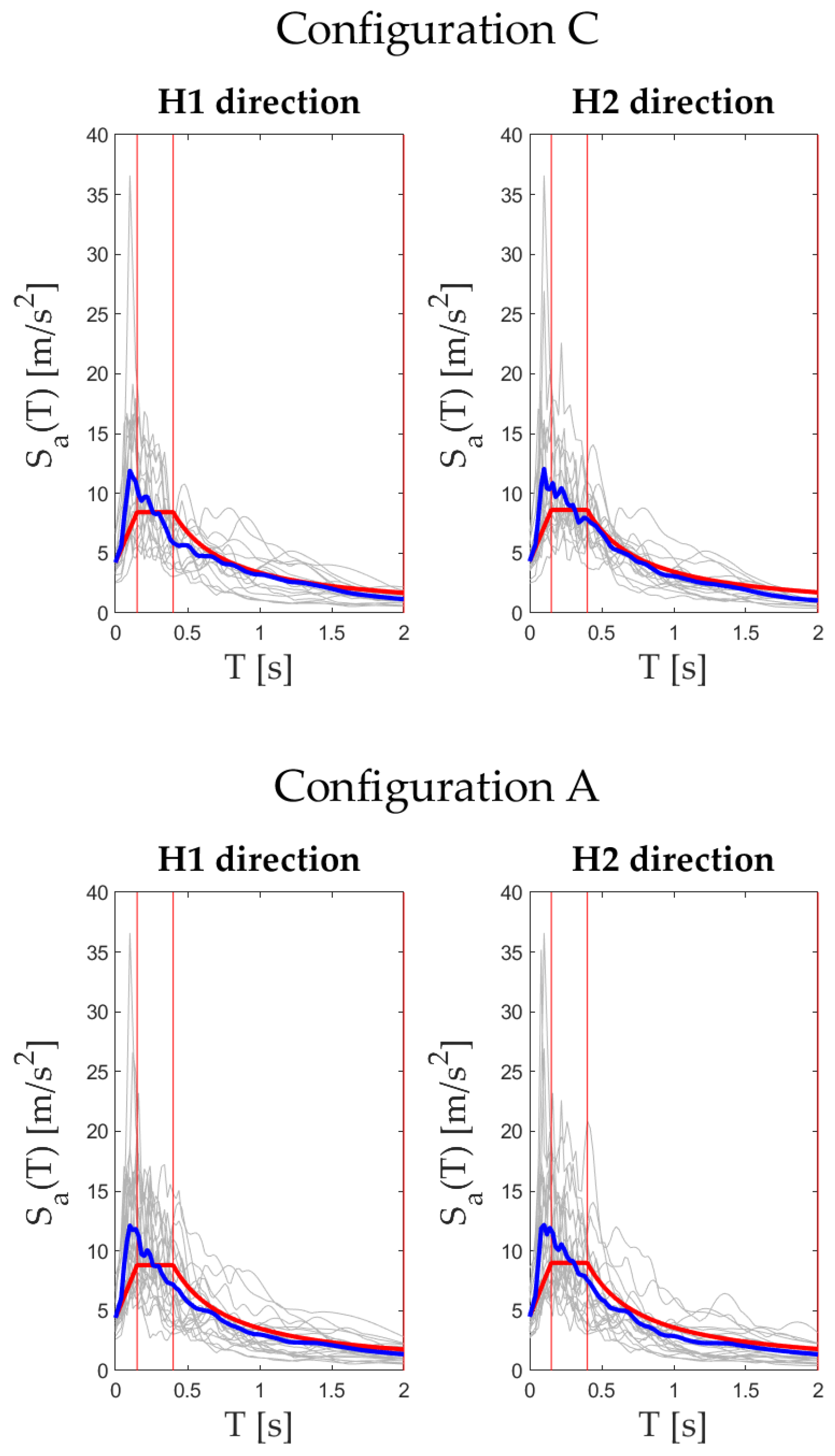


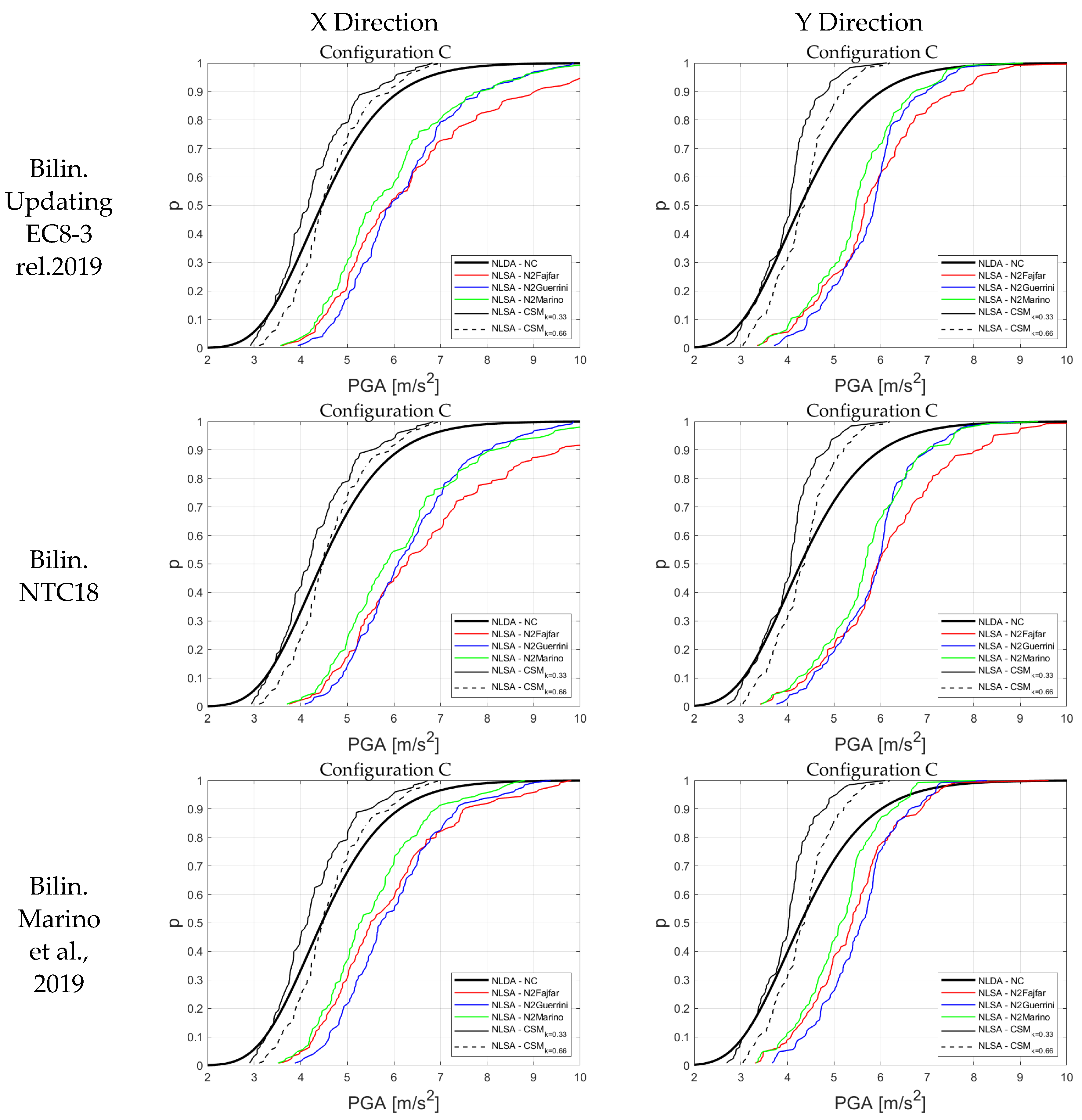
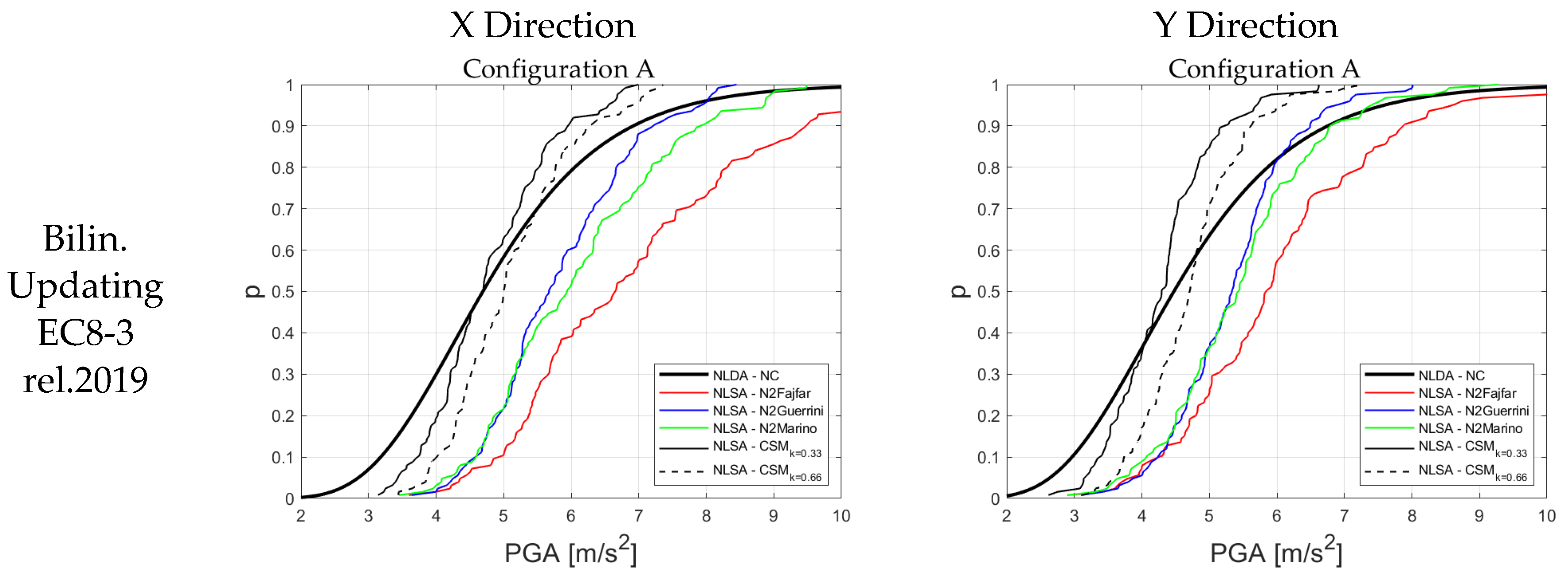
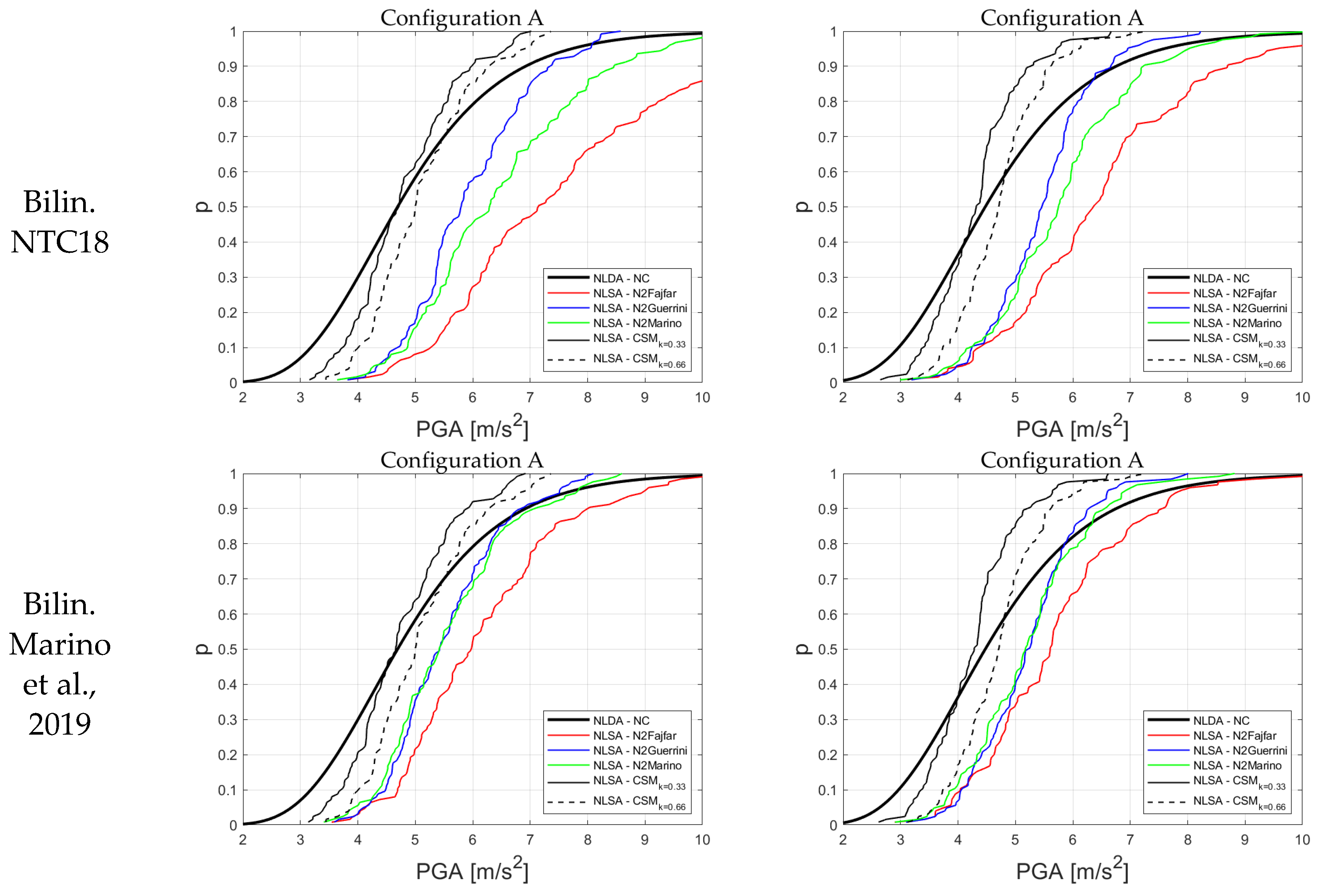

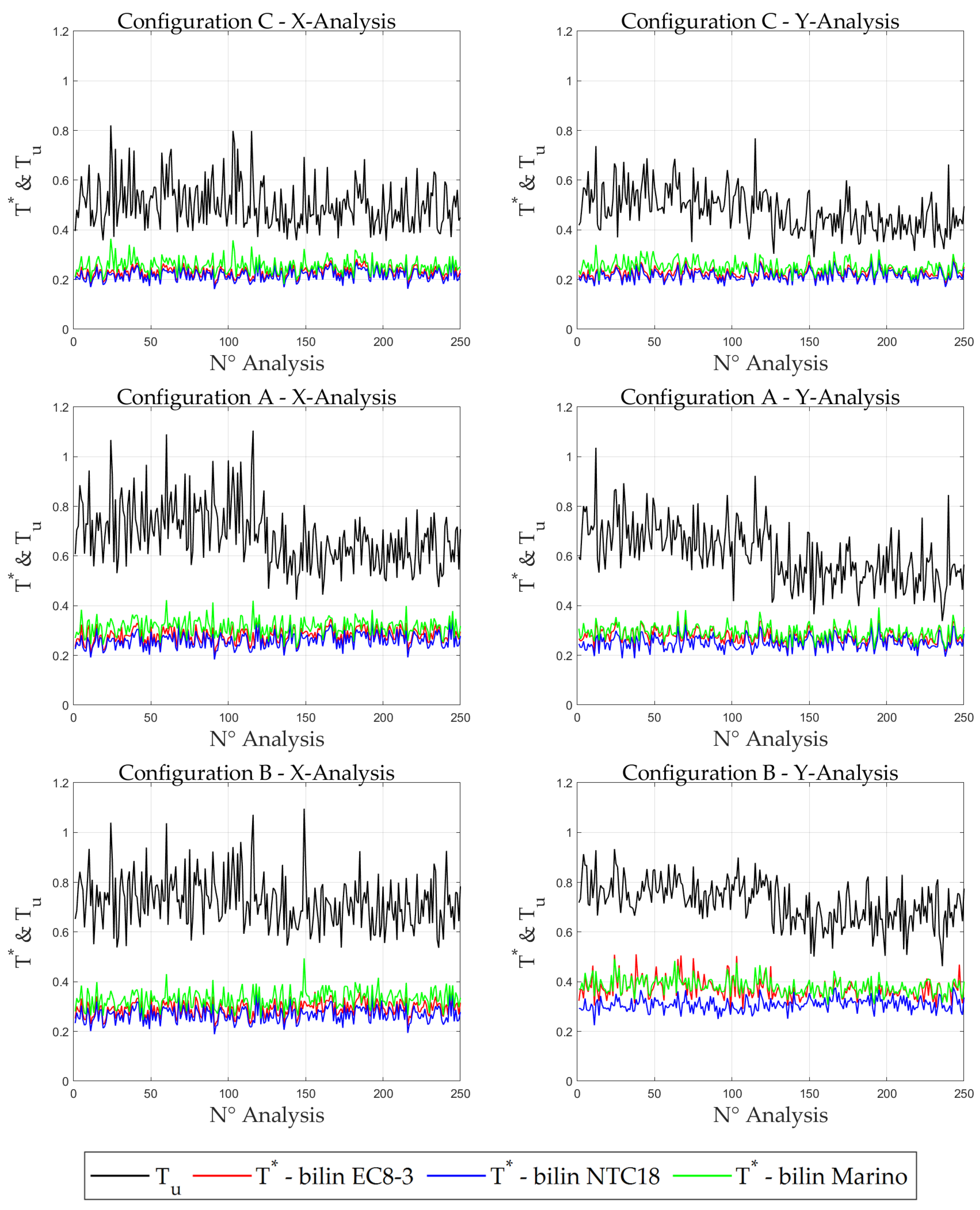

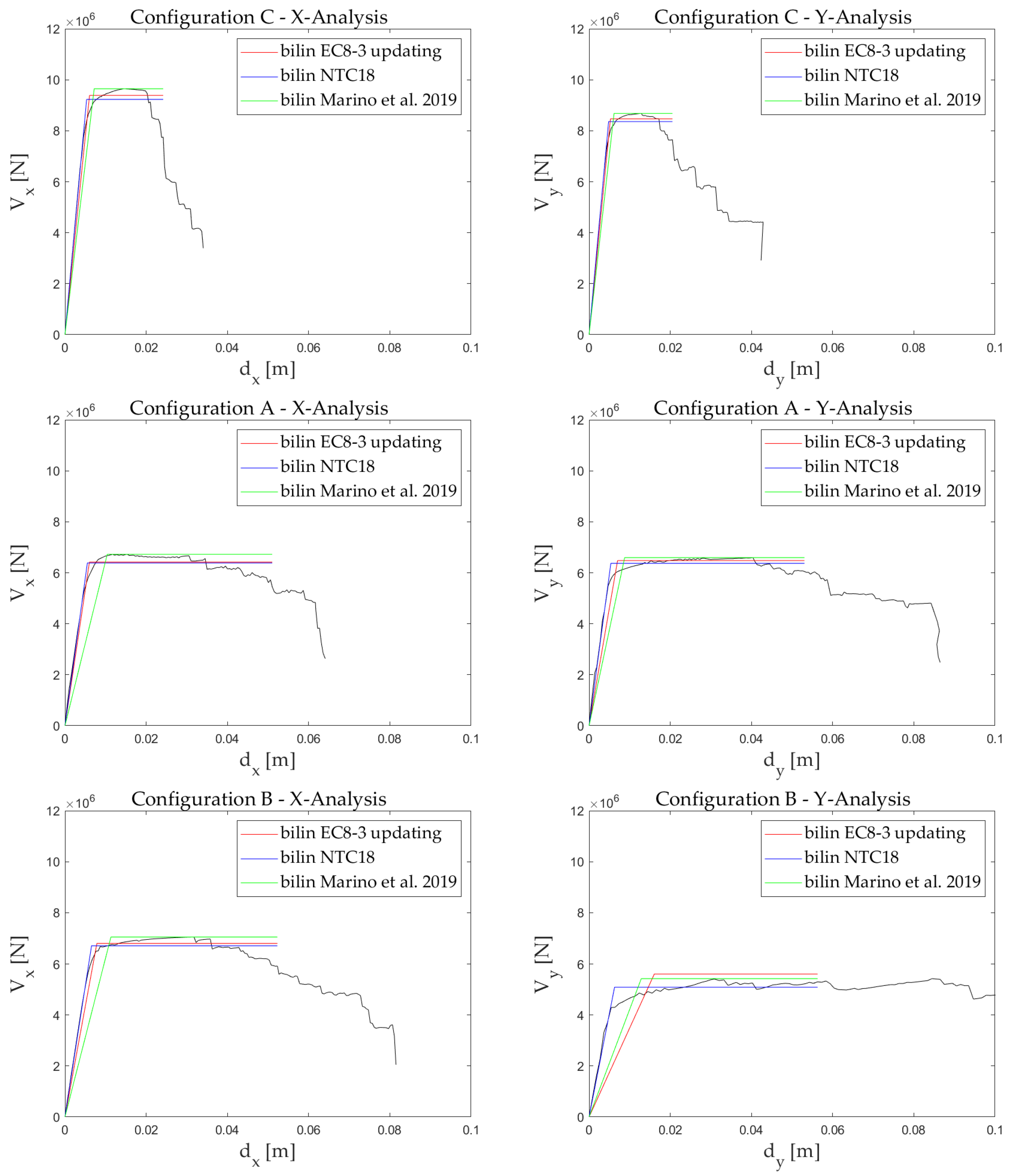
| Control | NC Limit State |
|---|---|
| Global | |
| Macroelement |
| Reference | Methods to Bilinearize the Capacity Curve for the NC Limit State |
|---|---|
| NTC2018 [8] | The stiffness k is calculated in correspondence to the 70% then, the stiffness k is kept constant, and the yield strength is calculated by the equivalence of the areas up to the displacement of collapse . |
| Updating EC8-3 rel.2019 [56] | Up to the base shear peak, the yield strength is kept constant, equal to the peak , and the stiffness k is calculated by imposing the equivalence of the areas up to ; after the base shear peak, the stiffness k is kept constant and equal to the value computed until the peak, while the yield strength is calculated by the equivalence of the areas up to the displacement of collapse . |
| Marino et al. (2019) [32] | For LSs associated with displacements up to the base shear peak, the stiffness k is calculated by the equivalence of the areas up to the displacement associated with the SL by assuming equal to the current value of the base shear at this point; for SLs associated with displacements after the base shear peak, the yield strength is kept equal to while the stiffness is computed by imposing the equivalence of the areas up the displacement of collapse . |
| Masonry typology | | E | G | | |
| min | min | min | min | ||
| med | med | med | med | ||
| max | max | max | max | ||
| Cut stone masonry | 2.6 | 0.0056 | 1500 | 500 | 21 |
| 3.2 | 0.0398 | 1740 | 580 | ||
| 3.8 | 0.0740 | 1980 | 660 | ||
| Full brick masonry with lime mortar | 2.6 | 0.05 | 1200 | 400 | 18 |
| 3.45 | 0.09 | 1500 | 500 | ||
| 4.3 | 0.13 | 1800 | 600 |
Disclaimer/Publisher’s Note: The statements, opinions and data contained in all publications are solely those of the individual author(s) and contributor(s) and not of MDPI and/or the editor(s). MDPI and/or the editor(s) disclaim responsibility for any injury to people or property resulting from any ideas, methods, instructions or products referred to in the content. |
© 2024 by the authors. Licensee MDPI, Basel, Switzerland. This article is an open access article distributed under the terms and conditions of the Creative Commons Attribution (CC BY) license (https://creativecommons.org/licenses/by/4.0/).
Share and Cite
Giusto, S.; Cattari, S.; Lagomarsino, S. Investigating the Reliability of Nonlinear Static Procedures for the Seismic Assessment of Existing Masonry Buildings. Appl. Sci. 2024, 14, 1130. https://doi.org/10.3390/app14031130
Giusto S, Cattari S, Lagomarsino S. Investigating the Reliability of Nonlinear Static Procedures for the Seismic Assessment of Existing Masonry Buildings. Applied Sciences. 2024; 14(3):1130. https://doi.org/10.3390/app14031130
Chicago/Turabian StyleGiusto, Sofia, Serena Cattari, and Sergio Lagomarsino. 2024. "Investigating the Reliability of Nonlinear Static Procedures for the Seismic Assessment of Existing Masonry Buildings" Applied Sciences 14, no. 3: 1130. https://doi.org/10.3390/app14031130





